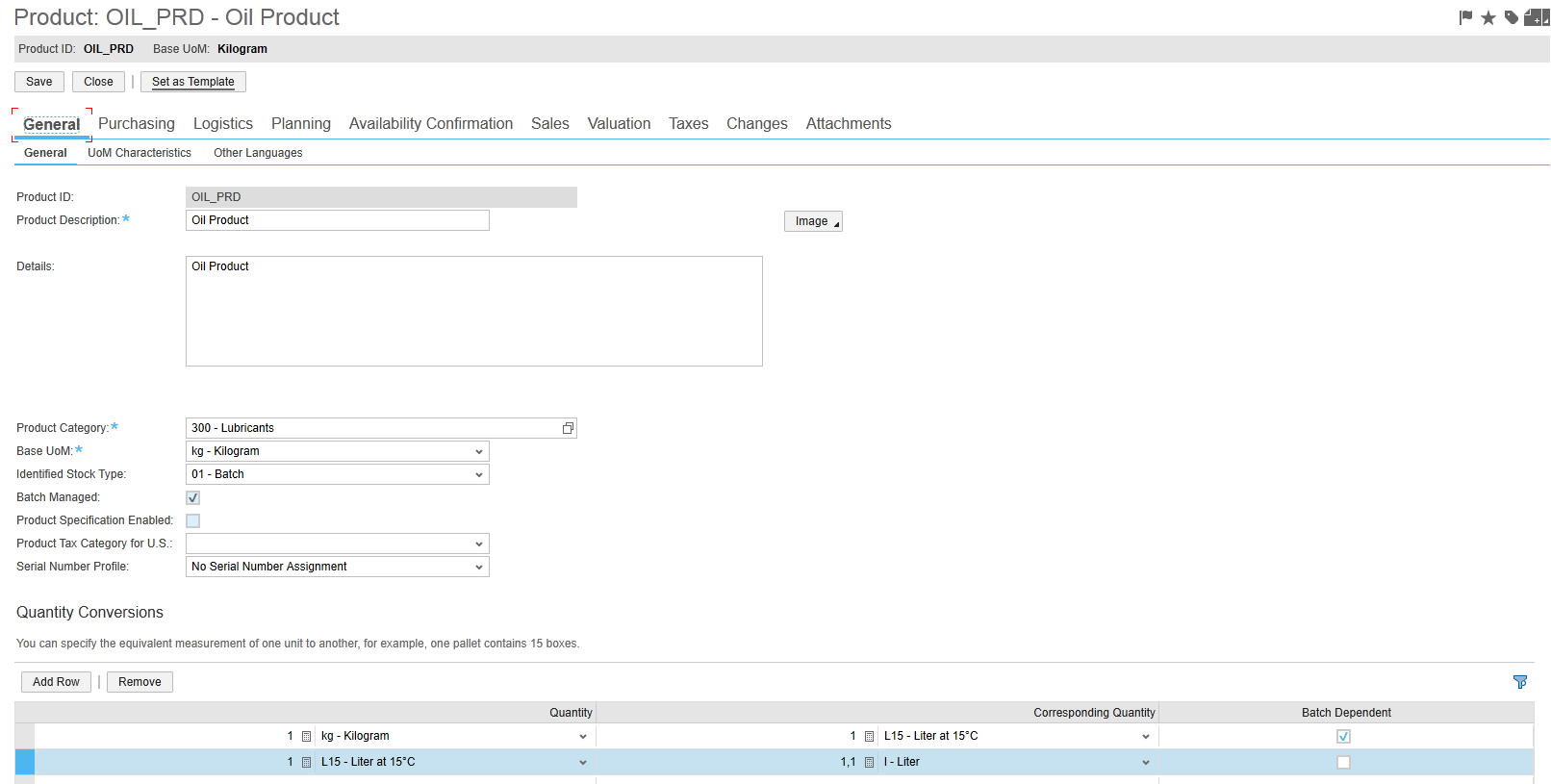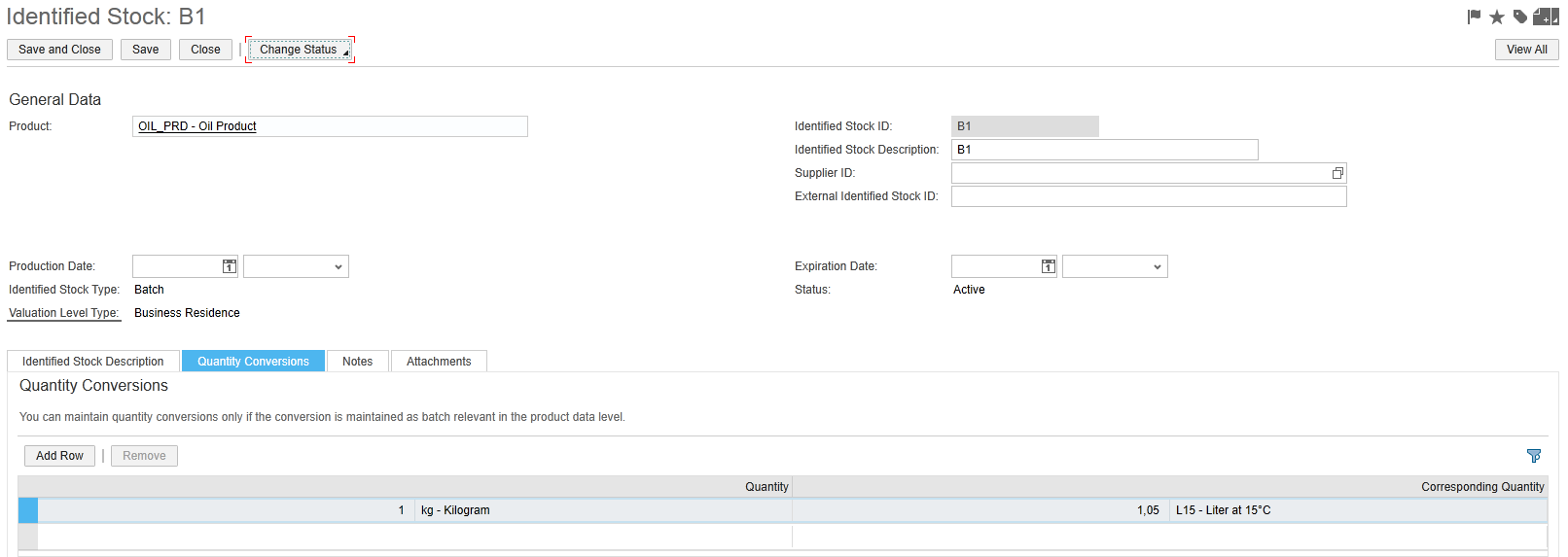
- SAP Community
- Products and Technology
- Enterprise Resource Planning
- ERP Blogs by SAP
- Batch Specific Conversions in SAP BusinessByDesign
- Subscribe to RSS Feed
- Mark as New
- Mark as Read
- Bookmark
- Subscribe
- Printer Friendly Page
- Report Inappropriate Content
In the blog ‘Innovation in our DNA’, we have explained in detail about the need from oil industry to handle oil density conversions at batch level and mentioned that ByDesign has a solution for that problem.
In this blog, I will take you through a simple 'Order to Cash' scenario and how the batch conversions are included in the entire process in SAP Business ByDesign.
a) Master Data Setup.
Creating the master data by carefully choosing the UOMs and marking the relevant UOMs as batch dependent is the crucial step
Few important points to note while defining master data are...
- ATP shall not consider batches while giving confirmations and ATP uses planning UOM as the basis for its confirmation. Hence, for getting accurate results considering planning view of inventory as per the batch conversions maintained at btach, the UOM conversion between the planning UOM and the UOM in which the Sales order will be created should be batch independent.
- Invoice in the ByDesign system doesn’t hold the batch information. Hence, we don’t support any batch related functionalities (viz., batch valuation, batch conversions etc) at invoice level. Quantity delivered and shown in Outbound delivery (which is always shown in order UOM), will be sent to Invoice for invoicing. Hence, the outbound delivery quantity (and hence the SO quantity) should always be
- in UOM that is basis from the standpoint of Invoice (or)
- in UOM, where the conversion between the invoice basis UOM to the order UOM is not batch dependent.
In the current example, I have a product, which has the following setup.
Base UOM : Kg
Inventory UOM : Kg
Planning UOM : L
Order UOM : L15
Invoice basis UOM : L15
1 Kg -> 1 L15 : Marked as batch dependent.
1 L15 -> 1.1 L : Marked as batch independent.

b) Inventory Build
Inventory for the product at a specific site can be build using any of the methods as per the business requirement. (viz., Production, External Procurement, Stock transfer etc). Since the focus of the blog is 'Order to Cash', in this post, we will directly refer to an existing inventory of 100 Kg for this product of a batch B1, where the conversion between Kg to L15 is maintained as 1.05.

For this batch, It can be seen in stock overview that the inventory of 100 Kg corresponds to 105 L15, considering the batch conversion.

c) Sales Order Creation
Lets create an order for 110 L15. System shall then provide confirmation to 105 L15, which is value of inventory in L15 considering the actual conversions at batch. (Had the product conversions are considered, then the ATP confirmation would have been 100 L15, as 1 Kg = 1 L15 as per product master)

d) Customer Demand : ATP Confirmation
In the customer demand too, it can be clearly seen that the requested quantity of 110 L15, got a confirmation of 105 L15, as per the inventory (considering batch level conversions).

e) Outbound Delivery
While creating OD, the task and the PGI screens have been enhanced to showcase the requested quantity in order UOM as well as the inventory UOM, such the warehouse worker will have an idea regarding the order quantity. (Earlier we were only showcasing the requested quantity only in inventory UOM)
As can be seen, when the batch is not entered, system showcases that the warehouse worker need to pick up 105 Kg for delivering 105 L15.

However, upon entering batch B1, system considers the conversions at batch B1 and suggests the user that 100 Kg of batch B1 is sufficient to deliver 105 L15.

User issues 100 kg of batch B1 and clicks 'Release' to create outbound delivery. Outbound Delivery gets created for 105 L15 by issuing inventory of 100 Kg of B1.

f) Invoice
The invoice request shall showcase the actual delivered quantity of 105 L15 as invoice relevant quantity. 
From Invoice request, invoice got created. 
Hope this blog helped in getting the idea of how the batch specific conversions are considered in the 'Order to Cash' scenario and also helped in understanding how the pain points laid out in earlier blog ‘Innovation in our DNA’, got resolved.
- V Krishna Anaparthi
- SAP Managed Tags:
- Oil, Gas, and Energy,
- SAP Business ByDesign,
- SAP Supply Chain Management
You must be a registered user to add a comment. If you've already registered, sign in. Otherwise, register and sign in.
-
Artificial Intelligence (AI)
1 -
Business Trends
363 -
Business Trends
20 -
Customer COE Basics and Fundamentals
1 -
Digital Transformation with Cloud ERP (DT)
1 -
Event Information
461 -
Event Information
23 -
Expert Insights
114 -
Expert Insights
150 -
General
1 -
Governance and Organization
1 -
Introduction
1 -
Life at SAP
415 -
Life at SAP
2 -
Product Updates
4,687 -
Product Updates
202 -
Roadmap and Strategy
1 -
Technology Updates
1,502 -
Technology Updates
85
- SAP ERP Functionality for EDI Processing: UoMs Determination for Inbound Orders in Enterprise Resource Planning Blogs by Members
- Sustainability with SAP S/4HANA Cloud Public Edition 2402 in Enterprise Resource Planning Blogs by SAP
- Activating SAP Actual Costing After implementing Material Ledger in SAP S/4HANA in Enterprise Resource Planning Blogs by SAP
- LSMW idoc method for uploading condition records using COND_A IN @SAP in Enterprise Resource Planning Blogs by Members
- Artificial Intelligence for SAP S/4HANA and SAP BTP: A deep dive in Enterprise Resource Planning Blogs by SAP
| User | Count |
|---|---|
| 5 | |
| 5 | |
| 4 | |
| 4 | |
| 3 | |
| 3 | |
| 3 | |
| 2 | |
| 2 | |
| 2 |